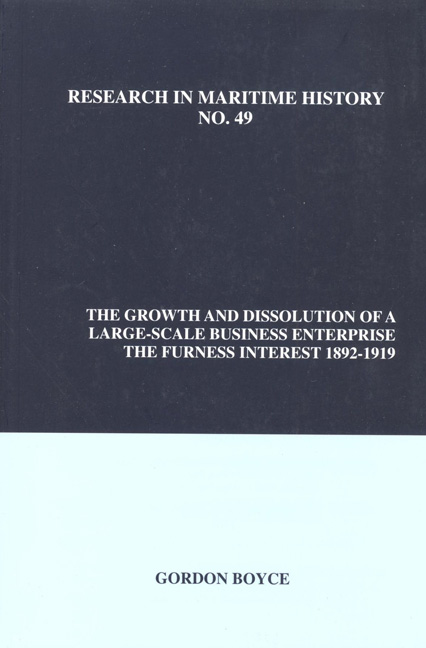Book contents
- Frontmatter
- Table of Contents
- About the Author
- Acknowledgements
- Figures and Tables
- Introduction
- Chapter 1 Furness' Shipping Services: Growth by Organic Means in the 1880s
- Chapter 2 The 1890s: Furness Withy's Expansion by Acquisition and Promotion
- Chapter 3 Diversification into the Industrial Sector, 1895-1901
- Chapter 4 Trouble on the Transatlantic Route: The Formation of the IMM and Furness' Response
- Chapter 5 The Growth of Shipping Services, 1902-1909
- Chapter 6 Industrial Operations and Performance, 1900-1914
- Chapter 7 The Growth of the Shipping Interests, 1910-1919
- Chapter 8 Structure
- Chapter 9 Finance
- Chapter 10 Holding Company Investment Activities and Intermediary Operations
- Chapter 11 Personnel
- Chapter 12 Furness
- Chapter 13 Dissolution
- Appendix 1 Development of the Combined Fleet, 1900-1919
- Appendix 2a Patterns of Ownership: The Furness Group, 1919
- Appendix 2b Reorganization of Branch Offices and Superintending Departments, 1911-1912
- Appendix 3a Fluctuations in Freights, Profits, Tonnage Afloat and Merchant Shipping Output
- Appendix 3b Output of Merchant Tonnage (Excluding Warships), 1892-1913
- Appendix 3c Fluctuations in the Price of a 7500-ton Cargo Steamer, 1898-1913
- Appendix 4 Development of the Furness Group: Principal Promotions, Acquisitions and Divestments, 1880-1919
- Appendix 5 Northern Allies and Maritime Associates
- Appendix 6 Contemporary Accounting Law and Conventions, 1845-1914
- Appendix 7 Lord Furness' Movements, 1899-1912
- Bibliography
Chapter 2 - The 1890s: Furness Withy's Expansion by Acquisition and Promotion
- Frontmatter
- Table of Contents
- About the Author
- Acknowledgements
- Figures and Tables
- Introduction
- Chapter 1 Furness' Shipping Services: Growth by Organic Means in the 1880s
- Chapter 2 The 1890s: Furness Withy's Expansion by Acquisition and Promotion
- Chapter 3 Diversification into the Industrial Sector, 1895-1901
- Chapter 4 Trouble on the Transatlantic Route: The Formation of the IMM and Furness' Response
- Chapter 5 The Growth of Shipping Services, 1902-1909
- Chapter 6 Industrial Operations and Performance, 1900-1914
- Chapter 7 The Growth of the Shipping Interests, 1910-1919
- Chapter 8 Structure
- Chapter 9 Finance
- Chapter 10 Holding Company Investment Activities and Intermediary Operations
- Chapter 11 Personnel
- Chapter 12 Furness
- Chapter 13 Dissolution
- Appendix 1 Development of the Combined Fleet, 1900-1919
- Appendix 2a Patterns of Ownership: The Furness Group, 1919
- Appendix 2b Reorganization of Branch Offices and Superintending Departments, 1911-1912
- Appendix 3a Fluctuations in Freights, Profits, Tonnage Afloat and Merchant Shipping Output
- Appendix 3b Output of Merchant Tonnage (Excluding Warships), 1892-1913
- Appendix 3c Fluctuations in the Price of a 7500-ton Cargo Steamer, 1898-1913
- Appendix 4 Development of the Furness Group: Principal Promotions, Acquisitions and Divestments, 1880-1919
- Appendix 5 Northern Allies and Maritime Associates
- Appendix 6 Contemporary Accounting Law and Conventions, 1845-1914
- Appendix 7 Lord Furness' Movements, 1899-1912
- Bibliography
Summary
In the decade following the restructuring of his interests, Furness continued to expand his transatlantic shipping services in the same cumulative manner as in the 1880s. Thus, branch offices and new business contacts continued to generate information about additional trading opportunities. The pattern of growth during the two decades was also similar. Furness strengthened his position on the main trunk routes (London and Liverpool to New York and Boston; shipowners referred to these as the “inside trades”) then dominated mainly by very large, long-established firms like Cunard, the White Star Line and several substantial American companies. At the same time, he continued to develop lines between secondary ports in the UK and North America and between lesser centres in North America and London and Liverpool. The methods he used, however, to extend his operations during the 1880s and 1890s differed in several respects. First, during the 1890s, Furness began purchasing firms to acquire their routes and tonnage. Second, as his network of business associates expanded beyond his local base in West Hartlepool, Furness developed new trades by taking part in joint ventures with shipping companies based in Liverpool, Hull and London, as well as firms engaged in other industries. In several cases the participants, some of whom had been shipbuilding clients of Furness, formed separate jointly-owned companies to control and manage the vessels deployed in a new service. Third, pursuing his practice of selling shares in single-ship companies with greater sophistication and on a much larger scale, Furness promoted a number of these enterprises as public limited-liability firms (appendix 4). While employing these means to extend his interests, Furness continued to focus his expansive energy primarily upon transatlantic routes during the 1890s.
The first task Furness undertook after forming Furness Withy was to acquire a large and long-established firm - Frederick Leyland and Co. - which had built up a large fleet of vessels that traded from Liverpool to Boston and the Mediterranean. When the founder died in 1892, his only son expressed no interest in running the family firm, and it became available for purchase.
- Type
- Chapter
- Information
- The Growth and Dissolution of a Large-Scale Business EnterpriseThe Furness Interest, 1892-1919, pp. 35 - 54Publisher: Liverpool University PressPrint publication year: 2012



